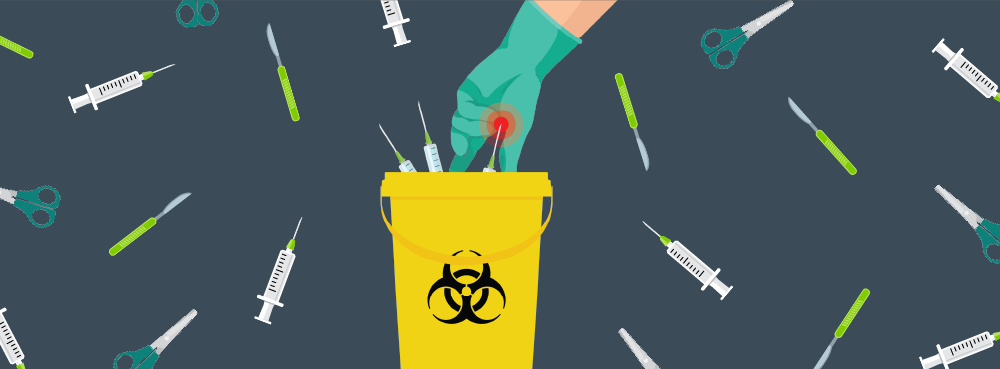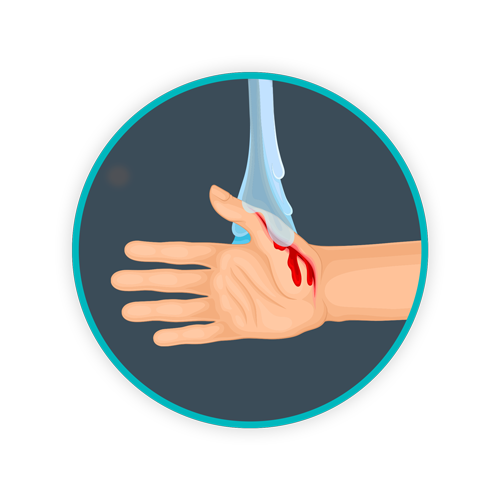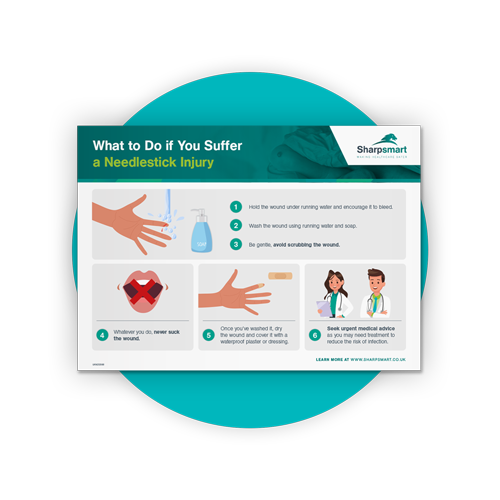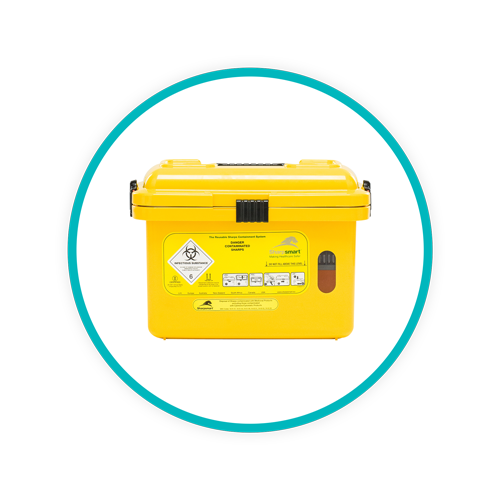How to Deal with a Sharps Injury

Have you ever found yourself stuck in your job? No, not like that, literally stuck – with a sharp object!
As a healthcare professional, it’s an occupational hazard you’re at an increased risk of suffering, so it’s worth knowing how to deal with a sharps injury as well as how to avoid them in the first place.
TOPICS WE WILL COVER:
1 / What are needlestick injuries?
2 / How to deal with a sharps injury.
3 / EVERY sharps injury should be reported.
4 / Prevent needlestick injuries with heightened awareness.
5 / Compliant sharps disposal for improved safety.
6 / Here for the headline? Skip the longer read with our blog summary.
What Are Needlestick Injuries?
A needlestick injury (NSI) is an incident wherein a person is accidentally pricked or cut by a sharp object (used in a medical procedure) resulting in it penetrating the skin. These types of injuries are also sometimes called sharps injuries or percutaneous injuries.
Despite the name, it’s not only needles that can cause these injuries. Sharps include a smorgasbord of medical equipment including syringes, scalpels, lancets, and even broken glass.
Most needlestick injuries occur in clinical areas like wards and theatres, but they can also occur in non-clinical areas as a result of accidental handling or improperly disposed of sharps – putting patients as well as other healthcare workers at risk.
Now you know what NSIs are (if you didn’t already), let’s look at what to do if you suffer one…

How to Deal with a Sharps Injury
Suffering a needlestick injury can be a terrifying and traumatising experience, especially if you pierce your skin with a used needle or sharp.
We urge you not to panic if you find yourself stuck, and follow these steps straight away:
1. Hold the wound under running water and encourage it to bleed.
2. Wash the wound using running water and soap.
3. Be gentle, avoid scrubbing the wound.
4. Whatever you do, never suck the wound.
5. Once you’ve washed it, dry the wound and cover it with a waterproof plaster or dressing.
6. Seek urgent medical advice as you may need treatment to reduce the risk of infection.
Sometimes, it can be difficult not to panic and suddenly the steps to follow to deal with a sharps injury simply leave your mind. This free-to-download poster can serve as a helpful visual aid in such a circumstance.

Click here to download your ‘What to do if you suffer a needlestick injury’ poster.
After all, with an estimated 100,000 needlestick injuries occurring each year in the UK, one can never have too many reminders.
EVERY Sharps Injury Should Be Reported
Despite the many reasons to report a sharps injury, many incidents still go unreported – le
aving others open to the risk of injury and potential subsequent infection.
This is partly due to the stigma around reporting NSIs and a fear of retaliation or discrimination for doing so, but this must change. The key proponent for this change is everyone doing their part and reporting EVERY sharps injury, whether the s
harp was used or brand new.
Doing so will help promote a culture of transparency, open communication, and sharps safety, and also decrease the risk of exposure to diseases and infections such as bloodborne viruses (BBV) – the main risk from an injury with a used sharp.
If you’re injured by a used sharp, we’d strongly recommend reporting it and seeking urgent medical advice to avoid delayed or inadequate treatment and potential long-term health implications.
This can also help you get access to a counsellor or support group to help you through the psychological side effects of a needlestick injury.
Prevent Needlestick Injuries with Heightened Awareness
Training and awareness programmes targeting compliance in sharps disposal and sharps safety are some of the most effective methods of preventing NSIs and keeping staff and patients safe.
One study conducted in a 730-bed acute district general hospital and published in 2020 measured the improved compliance of sharps bins after training was organised and awareness posters installed.
The study found that overall compliance improved from 44% in 2019 to 82.64% in 2020 – highlighting the necessity of regularly auditing sharps management and providing ongoing training and education.
Sharpsmart was founded on the premise of making healthcare safer and we’ve been actively raising awareness about sharps safety and reducing NSIs ever since, so as well as the poster we shared earlier in this blog (don’t forget to download it), we also offer many other free resources that you can make good use of:
Click here for more resources for preventing needlestick injuries.

Compliant Sharps Disposal for Improved Safety
Whilst knowing how to deal with a sharps injury is helpful information, avoiding NSIs in the first place is a much better method and we can help you do so.
Our experts can support you in providing training and education to raise awareness and improve compliance throughout your organisation for increased sharps safety – as well as providing you with the safest sharps containers on the market.
If you’d like more information on improving sharps awareness or are looking for safer sharps management and disposal solutions, don’t hesitate to get in touch.
Blog Summary
Suffering a needlestick injury can be terrifying but we urge you not to panic, and follow these steps straight away:
1. Hold the wound under running water and encourage it to bleed.
2. Wash the wound using running water and soap.
3. Be gentle, avoid scrubbing the wound.
4. Whatever you do, never suck the wound.
5. Once you’ve washed it, dry the wound and cover it with a waterproof plaster or dressing.
6. Seek urgent medical advice as you may need treatment to reduce the risk of infection.
Not panicking is easier said than done and logical information may leave your mind if you do. This free-to-download poster can serve as a helpful visual aid in such a circumstance.
Click here to download your ‘What to do if you suffer a needlestick injury’ poster.
After all, with an estimated 100,000 needlestick injuries occurring each year in the UK, one can never have too many reminders.
Whether the sharp you’ve been injured with is used or brand new, EVERY sharps injury must be reported.
If it’s a used sharp, seek urgent medical advice. This will help you avoid delayed or inadequate treatment and potential long-term health implications and access psychological support.
Sharpsmart was founded on the premise of making healthcare safer and we’ve been actively raising awareness about sharps safety and reducing NSIs ever since. Discover our many free resources:
Click here for more resources for preventing needlestick injuries.
Changed your mind and want to read the full blog? Click here to head back to the top!
Let's Talk!
Your time is valuable, and we don’t want to play hard to get. You can either phone us directly on the details listed on our contact page, or feel free to fill out this short form and one of our team members will get back to you as quickly as possible.
